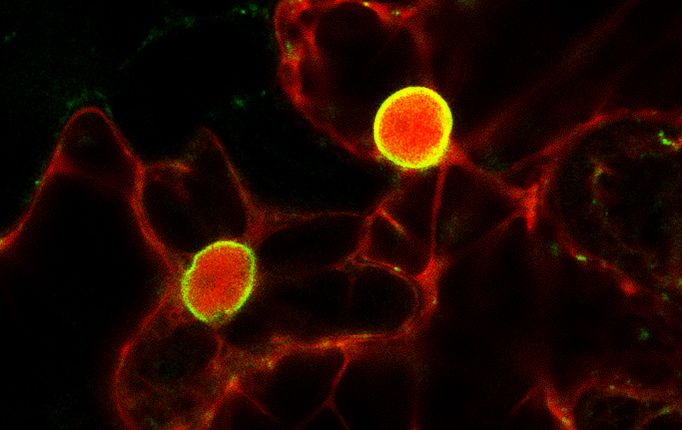
Transient expression of nuclear envelope protein PNET1 fused with the green fluorescent protein in plant cells. Red fluorescent protein labels the nucleoplasm and cytoplasm. Photo by Yu Tang.
The nuclear envelope (NE), a double membrane that surrounds chromatin, is a key element of the nucleus in all eukaryotic cells. While the membrane is well understood to be involved in essential cellular functions—for example, serving as a critical interface in transmitting signals from the cell periphery into the genome—the various functions and components of NE proteins in plants are far less clear.
In two new studies, published today in Nature Plants and Nature Communications, assistant professor of plant immunity and cell biology Yangnan Gu and postdoctoral researchers Yu Tang and Min Jia have developed a novel mapping method to better understand the NE proteome in plants. In the Nature Plants study, the researchers use proximity-labelling and quantitative mass spectrometry to develop a novel protein-profiling technology, revealing the NE protein landscape of the plant Arabidopsis with unprecedented precision.
In the Nature Communications study, Gu and co-authors Tang and Jia, along with researchers from Tsinghua University, unraveled the destruction mechanism of proteins that selectively accumulate at the inner nuclear membrane (INM). These proteins are essential for nuclear function, but their overaccumulation leads to various genetic disorders. The study identifies critical INM-associated protein degradation machinery to remove excessive INM proteins in Arabidopsis.
“Active removal of aberrantly accumulated proteins and replacing defective molecules at the INM is of critical importance to the homeostasis and integrity of the nucleus,” says Gu. “However, little is known about this process in plant and animal cells.”
Various genetic disorders in humans have been closely linked with mutations in human NE genes. The spectrum of these diseases are collectively termed nuclear envelopathies, the list of which continues to expand. Such studies, by helping researchers better understand the composition and controlling mechanisms for protein dynamics in NE membranes, could lend insight into evolutionarily-conserved NE protein functions in humans that play a role in many common diseases.
“These studies represent an important step towards a comprehensive understanding of fundamental biological principles that underlie the nuclear membrane—the hallmark of our cells,” says Gu.
Gu is also a member of the Berkeley Innovative Genomics Institute. These studies were conducted in conjunction with researches at Tsinghua University, Beijing.
Read more:
